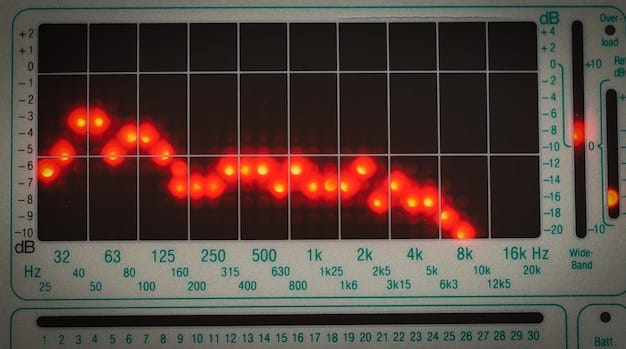Algorithmic Trading for Beginners: Build a Python Strategy

Algorithmic trading for beginners involves creating a simple strategy using Python to automate stock market decisions based on predefined rules and analysis.
Ready to automate your investments? Let’s dive into algorithmic trading for beginners: building a simple strategy with Python. This guide breaks down the complexities, offering a clear path to creating your first automated trading system.
What is Algorithmic Trading?
Algorithmic trading, also known as automated trading or black-box trading, uses computer programs to follow a defined set of instructions (an algorithm) for placing a trade. These programs can execute trades at a speed and frequency that is impossible for a human trader, often reacting to market conditions in milliseconds.
Benefits of Algorithmic Trading
Algorithmic trading offers several advantages over traditional manual trading, making it an attractive option for both beginners and experienced investors.
- Speed and Efficiency: Algorithms can execute trades much faster than humans, capitalizing on fleeting opportunities in the market.
- Reduced Emotional Influence: Algorithmic trading eliminates emotional biases that can lead to poor decision-making.
- Backtesting Capabilities: Strategies can be tested on historical data to evaluate their performance before being deployed in live markets.
- 24/7 Trading: Algorithms can monitor and trade markets around the clock, even when you’re asleep.
Algorithmic trading isn’t just for Wall Street giants anymore. With Python, anyone can create their own automated trading system and potentially improve their investment outcomes.

Setting Up Your Python Environment
Before you can start building your first algorithmic trading strategy, you need to set up your Python environment. This involves installing Python, along with the necessary libraries for data analysis and trading.
Installing Python and pip
First, download and install the latest version of Python from the official Python website. Make sure to check the box that adds Python to your system’s PATH environment variable during installation.
Essential Python Libraries
Several Python libraries are essential for algorithmic trading. These include:
- Pandas: For data manipulation and analysis.
- NumPy: For numerical computing and array operations.
- yfinance: For downloading historical stock data from Yahoo Finance.
- TA-Lib: For calculating technical indicators.
- Alpaca Trade API: For connecting to a brokerage and executing trades.
To install these libraries, open your command prompt or terminal and use pip (Python’s package installer):
pip install pandas numpy yfinance TA-Lib alpaca-trade-apiWith your environment set up, you’re ready to start building your trading strategy.
Defining Your Trading Strategy
The core of any algorithmic trading system is the trading strategy. This is the set of rules that determine when to buy or sell an asset. A well-defined strategy is crucial for success in algorithmic trading.
Simple Moving Average (SMA) Crossover Strategy
One of the simplest and most popular trading strategies is the SMA crossover. This strategy involves comparing two SMAs, one with a shorter period and one with a longer period. When the shorter SMA crosses above the longer SMA, it’s considered a buy signal. Conversely, when the shorter SMA crosses below the longer SMA, it’s a sell signal.
Backtesting Your Strategy
Backtesting involves testing your strategy on historical data to evaluate its performance. This helps you identify potential flaws and optimize your strategy before deploying it in live markets.
- Data Collection: Gather historical price data for the asset you want to trade.
- Strategy Implementation: Write Python code to implement your trading strategy using the historical data.
- Performance Evaluation: Analyze the results of your backtest, looking at metrics such as profit factor, win rate, and maximum drawdown.
Defining and backtesting your trading strategy is a critical step in algorithmic trading. It allows you to refine your approach and increase your chances of success.

Implementing the SMA Crossover Strategy with Python
Now, let’s implement the SMA crossover strategy using Python. This involves downloading historical stock data, calculating the SMAs, and generating buy and sell signals.
Downloading Historical Stock Data
We’ll use the `yfinance` library to download historical stock data for a specific ticker.
import yfinance as yf
import pandas as pd
# Download historical data for Apple (AAPL)
ticker = "AAPL"
data = yf.download(ticker, start="2023-01-01", end="2024-01-01")Calculating Simple Moving Averages
Next, we’ll calculate the shorter and longer SMAs using the `rolling` and `mean` methods in Pandas.
# Calculate short and long SMAs
short_window = 20
long_window = 50
data['SMA_Short'] = data['Close'].rolling(window=short_window).mean()
data['SMA_Long'] = data['Close'].rolling(window=long_window).mean()Generating Buy and Sell Signals
Now, we’ll create a function to generate buy and sell signals based on the SMA crossover.
# Generate buy and sell signals
data['Signal'] = 0.0
data['Signal'] = np.where(data['SMA_Short'] > data['SMA_Long'], 1.0, 0.0)
data['Position'] = data['Signal'].diff()This code calculates the SMAs and generates buy and sell signals based on the crossover strategy. You can then use these signals to execute trades automatically.
Connecting to a Brokerage with Alpaca Trade API
To execute trades automatically, you need to connect your Python script to a brokerage account. Alpaca Trade API is a popular option for algorithmic trading, offering commission-free trading and a simple API.
Creating an Alpaca Account
First, create an account on the Alpaca website. You’ll need to generate an API key and secret key, which you’ll use to authenticate your Python script.
Installing the Alpaca Trade API Library
Install the `alpaca-trade-api` library using pip:
pip install alpaca-trade-apiExecuting Trades
Now, you can use the Alpaca Trade API to execute trades based on your buy and sell signals.
from alpaca_trade_api.rest import REST, TimeFrame
# Replace with your API key and secret key
api_key = "YOUR_API_KEY"
api_secret = "YOUR_SECRET_KEY"
api = REST(api_key, api_secret, base_url="https://paper-api.alpaca.markets")
# Get the last trade for AAPL
last_trade = api.get_latest_trade("AAPL")
symbol = "AAPL"
qty = 1
if data['Position'][-1] == 1:
api.submit_order(
symbol=symbol,
qty=qty,
side='buy',
type='market',
time_in_force='gtc'
)
elif data['Position'][-1] == -1:
api.submit_order(
symbol=symbol,
qty=qty,
side='sell',
type='market',
time_in_force='gtc'
)Connecting to a brokerage and automating trade execution is the final step in building your algorithmic trading system.
Risk Management and Position Sizing
Effective risk management is crucial for protecting your capital and ensuring the long-term viability of your trading strategy. Position sizing is a key component of risk management.
Setting Stop-Loss Orders
A stop-loss order is an order to sell an asset when it reaches a certain price. This helps limit your potential losses on a trade.
Determining Position Size
Position sizing involves determining the appropriate amount of capital to allocate to each trade. A common approach is to risk a fixed percentage of your capital on each trade.
- 1% Rule: Risk no more than 1% of your capital on any single trade.
- Volatility-Based Sizing: Adjust your position size based on the volatility of the asset.
- Account Size: Adjust the total trade size in accordance to the amount accessible on the account.
Risk management and position sizing are essential for protecting your capital and maximizing your returns in algorithmic trading.
| Key Point | Brief Description |
|---|---|
| 💡 SMA Crossover | Uses short and long Simple Moving Averages to generate buy/sell signals. |
| 🛠️ Python Setup | Install Python and libraries like Pandas, NumPy, and yfinance. |
| 📊 Backtesting | Test your strategy on historical data to evaluate its performance. |
| 🛡️ Risk Management | Use stop-loss orders and proper position sizing to protect your capital. |
FAQ
▼
Algorithmic trading uses computer programs to execute trades based on predefined rules, enabling faster and more efficient trading decisions.
▼
It offers benefits such as increased speed, reduced emotional bias, backtesting capabilities, and the ability to trade 24/7.
▼
The SMA crossover strategy involves comparing shorter-term and longer-term Simple Moving Averages to generate buy and sell signals.
▼
Backtesting is the process of testing a trading strategy on historical data to evaluate its performance and identify potential weaknesses.
▼
You can use APIs like Alpaca Trade API to connect your Python script to a brokerage account and automate trade execution.
Conclusion
Embarking on algorithmic trading for beginners: building a simple strategy with Python may seem daunting, but with the right tools and knowledge, it’s entirely achievable. By understanding the basics of algorithmic trading, setting up your Python environment, defining your trading strategy, and implementing risk management techniques, you can create your own automated trading system. Remember to continuously backtest and refine your strategy to adapt to changing market conditions.





